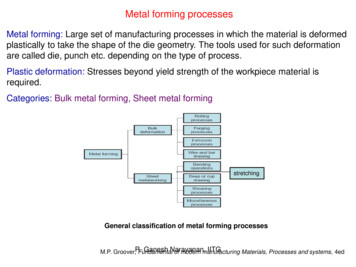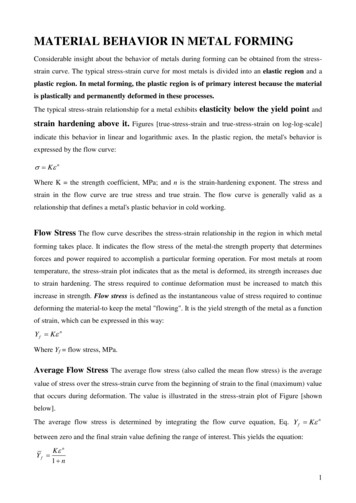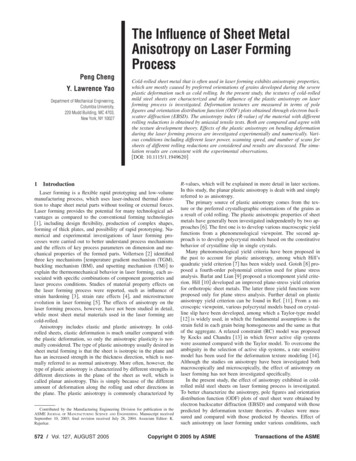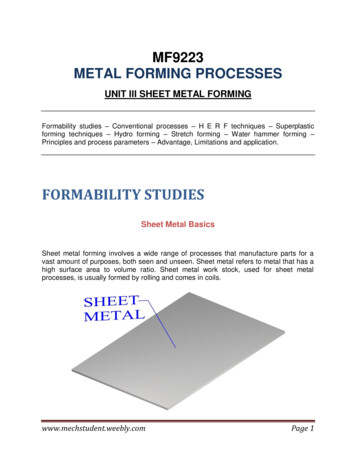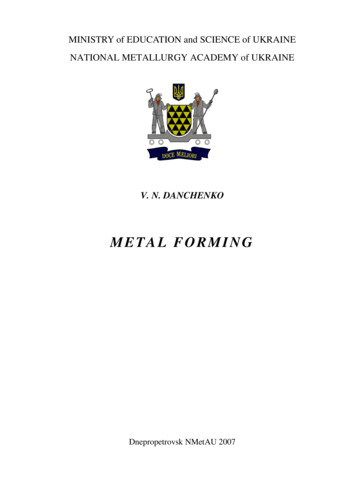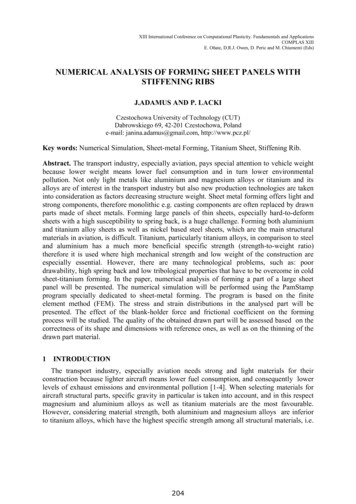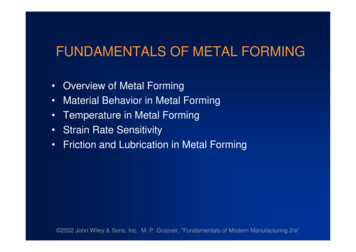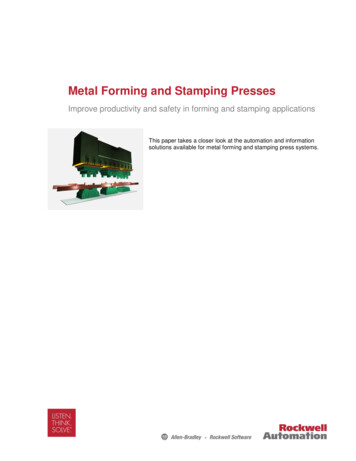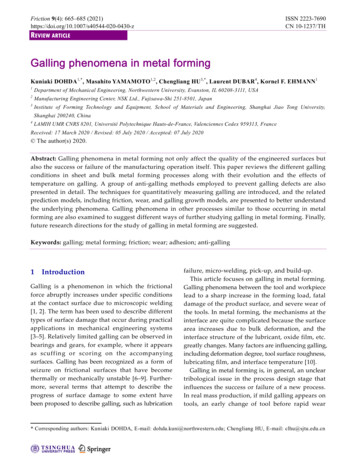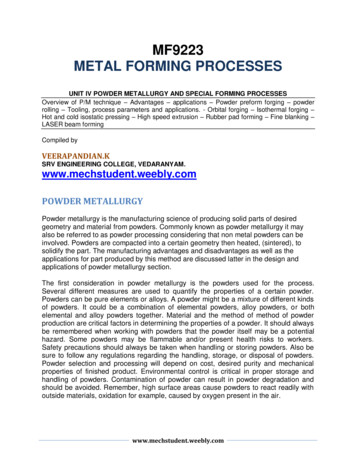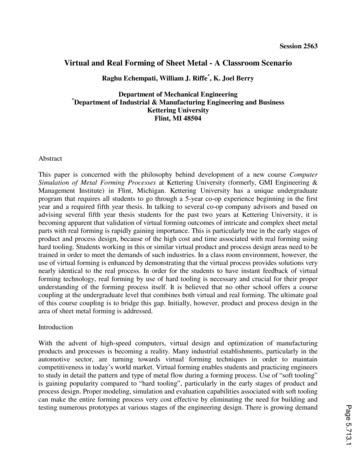
Transcription
Session 2563Virtual and Real Forming of Sheet Metal - A Classroom ScenarioRaghu Echempati, William J. Riffe*, K. Joel BerryDepartment of Mechanical EngineeringDepartment of Industrial & Manufacturing Engineering and BusinessKettering UniversityFlint, MI 48504*AbstractThis paper is concerned with the philosophy behind development of a new course ComputerSimulation of Metal Forming Processes at Kettering University (formerly, GMI Engineering &Management Institute) in Flint, Michigan. Kettering University has a unique undergraduateprogram that requires all students to go through a 5-year co-op experience beginning in the firstyear and a required fifth year thesis. In talking to several co-op company advisors and based onadvising several fifth year thesis students for the past two years at Kettering University, it isbecoming apparent that validation of virtual forming outcomes of intricate and complex sheet metalparts with real forming is rapidly gaining importance. This is particularly true in the early stages ofproduct and process design, because of the high cost and time associated with real forming usinghard tooling. Students working in this or similar virtual product and process design areas need to betrained in order to meet the demands of such industries. In a class room environment, however, theuse of virtual forming is enhanced by demonstrating that the virtual process provides solutions verynearly identical to the real process. In order for the students to have instant feedback of virtualforming technology, real forming by use of hard tooling is necessary and crucial for their properunderstanding of the forming process itself. It is believed that no other school offers a coursecoupling at the undergraduate level that combines both virtual and real forming. The ultimate goalof this course coupling is to bridge this gap. Initially, however, product and process design in thearea of sheet metal forming is addressed.IntroductionPage 5.713.1With the advent of high-speed computers, virtual design and optimization of manufacturingproducts and processes is becoming a reality. Many industrial establishments, particularly in theautomotive sector, are turning towards virtual forming techniques in order to maintaincompetitiveness in today’s world market. Virtual forming enables students and practicing engineersto study in detail the pattern and type of metal flow during a forming process. Use of “soft tooling”is gaining popularity compared to “hard tooling”, particularly in the early stages of product andprocess design. Proper modeling, simulation and evaluation capabilities associated with soft toolingcan make the entire forming process very cost effective by eliminating the need for building andtesting numerous prototypes at various stages of the engineering design. There is growing demand
for engineers trained in this area, as many companies engaged in metal forming research are turningtowards virtual forming. Kettering University recently funded a grant proposal to procure ahydraulic press that has adaptive controls allowing experiments in non-circular forming andparametric studies that will facilitate the creation of real forming models for subsequent simulation.Another grant proposal is in preparation stage requesting funds to procure a dedicated high-speedcomputer server and terminals to support the virtual forming laboratory. As mentioned before, theobjective of this paper is to share ideas on the philosophy of combining virtual and real metalforming technology.Kettering University has offered a class on Sheet Metal Forming based on hard tooling and realforming processes for over forty years, and a new separate elective course on virtual metal formingusing software tools is being prepared. While the real forming part of the course deals withperforming laboratory experiments for validation and testing of simple formed parts; the virtualforming course emphasizes the parametric studies of the metal forming variables using thecomputer numerical simulation techniques. In the long term, these two courses will work togetherto provide industry with students trained in real and virtual metal forming processes in an appliedmanner. The goals and objectives of this course sequence follow the mission and goals of KetteringUniversity in general, and the goals of the respective departments in particular. The overalluniversity goal is to enhance the undergraduate and graduate education through hands-on educationand to promote inter-disciplinary applied research activities.The question is therefore raised: “Does concurrent coursework in real and virtual forming ofsheet metal enhance the understanding of the technology of both fields?” This paper describesthe beginning of an attempt to answer that question.BackgroundThe ME department consists of 38 full-time faculty and the IMEB Department has 29 facultymembers, out of which 7 serve the Manufacturing Systems Engineering students. During the lasttwo years, Mechanical Engineering Department initiated a reform effort that includes theintegration of technology and design throughout the curriculum. The primary goal is to exposeundergraduate students to high-end Computer Aided Engineering (CAE) software and designmethodologies for virtual design and optimization. This focus resulted in the definition of several21st Century Core Technological Challenges (CTC). Two of these challenges are ManufacturingEngineering & Micro Technologies in addition to Simulation Engineering & MDO (MultiDisciplinary Design Optimization). The objectives and goals presented in this paper support theabove CTC focus and will help faculty prepare students that understand industry’s requirement fora reduction in the overall design cycle through the use of CAE tools for Virtual DesignManufacturing (VDM).Page 5.713.2Rapid technological and economic changes within Mechanical and Manufacturing Engineeringhave left many colleges and universities hard-pressed to prepare graduates for the latest technicaland managerial trends, as well as to impart the high-end CAE skills needed to serve society andindustry. Some schools are rising to the challenge by developing interdisciplinary courses, poolingresources both within their university and with other academic institutions, and partnering withprivate industry and/or government to better prepare their students for the realities of professional
engineering. Manufacturing and engineering companies around the world have begun to buildvirtual products and processes that can communicate across the barriers of time, distance,discipline, and culture.In the metal forming area, these firms are finding that the return on investment from the applicationof virtual forming technology is one of the most exciting recent developments in computersimulation. So far, metal forming is still considered more of an art than science. This is due to thedifficulty of transferring the forming technology into a knowledge database for proper parametricmodeling and analysis using high-speed computational tools. Early adopters have alreadydiscovered that the integration of such software can enhance collaborative engineering,significantly reduce design-cycle time as well as the need for physical prototypes and models, andincrease a product’s ultimate market acceptance and penetration. While the usual CAD software istypically designed for non-real-time modeling, interactive simulation software such as LS-DYNA along with pre- and post-processor software can produce real-time visualization and interaction ofthe results. The overall gains of this effort are based on the ability to involve a far greater numberof students (and later engineers) who are involved in the design and manufacture of a product.To accomplish some of these ideas, the developmental efforts focus on further enhancement andfuture integration of two courses that are currently offered at Kettering University. The MfgE-404Sheet Metal Forming course is offered by IMEB Department (with ME-202: Mechanics of Solidsand MfgE-370: Engineering Materials as pre-requisites), and ME-510 Computer Simulation ofMetal Forming Processes (with MfgE-370, ME-315: Computer Aided Engineering and ME-342:Advanced Solids as pre-requisites, and possibly ME-429: Finite Elements as co-requisite). Catalogdescription of these courses is outlined in Appendix 1.Itemized objectives of the detailed planI. Enhancement of the existing Sheet Metal Forming course(i)upgrade the existing stamping laboratory by procuring a hydraulic press and theaccompanying controls and tooling(ii)prepare a set of experiments in the redraw and reverse redraw of simple parts(iii) develop the necessary press and tooling data to generate Forming Limit Diagramsfor different materials such as a variety of steels, aluminum and other materials(iv)prepare handouts and laboratory manual that includes all of the experiments in themetal forming area(v)upgrade the existing laboratory experiments and class notesII.(i)(ii)(iii)Page 5.713.3(iv)Enhancement of the existing Computer Simulation of Metal Forming courseupgrade the existing CAE laboratories by procuring a high speed computer serversuch as the Sun Enterprise 3500 with enough memory capacity and 70 GB of diskspace to educate more students and for the thesis students to run simulation of someof the actual sheet metal parts from their co-op companiesdevelop handouts, class notes and computer laboratory manualto enhance faculty research in virtual forming and support the integration of appliedresearch into the undergraduate curriculumintroduce the virtual and real forming courses at the graduate level
Of the above two courses, the MfgE-404 is well established that has both lecture and hands onlaboratory content. The class size is around 40 per term and it is offered during Winter and Springterms. Some of the students taking this class work in the sheet metal forming area for their co-opcompany and quite often they choose their thesis topic in this area. The laboratory requires studentsto work in groups of 3 to 5 with either 4 or 5 groups per lab section. Because of the high number ofstudents in the class, multiple lab sections are required. The experiments are designed to be openended with a prescribed sequence of operations to follow but no indication of where the experimentwill terminate except to say that all experiments are pushed until the tooling has been exhausted orthe material fractures. The experiments are divided into three categories: material properties forsheet metal forming; draw tooling where the effects of die entry radius, punch nose radius, punchto-die clearances and attendant press signatures are examined, and hole expansion; and otherprocesses such as stretching, bending, and lubrication. A small hand-operated press provideslimited opportunity to demonstrate redrawing and reverse redrawing. A sufficient supply ofdifferent steels is used so that the material effects are also considered in most experiments.Laboratory reports detail the experiment, the observations, pertinent calculations of strain andtooling interactions, and other conclusions reached by the team. Figure 1 in Appendix 2 showsexamples of stamped parts in this laboratory. As mentioned above, the current mechanical presswould require extensive modifications and tooling to study redraw and reverse redraw situationsand to control the load and depth ranges to investigate other geometric effects.Some of the above mentioned difficulties are partially addressed in the ME-510 course byconducting several LS-DYNA runs with the different forming parameters varied. This course isalso offered during Winter and Spring terms. Lecture classes cover the introductory theory requiredto understand the applications of nonlinear material properties (plasticity) and nonlinear finiteelement analysis to the modeling and simulation of large deformation problems in metal forming.Some of the computational issues like the hourglass modes and stability are also discussed anddemonstrated on the computer. Appendix 3 shows the detailed outline, learning outcomes andlearning objectives of the ME-510 course.Page 5.713.4The students start off by observing the one-step (Quikstamp or FastForm 3D ) and theincremental (LS-DYNA ) results of example problems that are provided by these softwarecompanies. Due to computer resource limitations, they then attempt to simulate simple problemsfollowing the tutorials provided to them. For their project, students attempt to perform parametricstudies to simulate the bending and drawing operations that are done in the MfgE-404 laboratory.Fig. 2 in Appendix 2 shows results of a simple example of a cup draw using the Quikstamp onestep solver. These results are for quarter-symmetry model of a full cup drawn in the sheet metallaboratory that show the geometry of the tooling, metal flow in the circumferential and radialdirections, and thinning in the z direction. Also, forming limit diagrams (FLD) can be obtained asshown to understand the drawbility of parts. As mentioned earlier, the corresponding incrementalsolution for this model takes much longer time than the one-step solution. However, theincremental solution gives more predictable and step by step results that are required especially fornon-circular or asymmetric problems. The biggest draw back at the present time is the limitation onthe computational power in terms of the computer speed and the available disk space per student.This keeps the class size to fewer than ten students per term. Although it may be possible toconduct the simulation laboratory as a demonstration laboratory, the student background and co-op
education at Kettering University requires more hands-on experience. Moreover, it is desirable forthe students working in the stamping area for their fifth year thesis to run simulation of real partswhile they are on campus. Some of the recent students’s thesis titles are given in Appendix 4.Evaluation and dissemination toolsInitially, some of the commonly adopted assessment tools will be used either in person or via email or through Internet. These are: on campus tests, homework, laboratory reports and paperswritten out of thesis work, student surveys, alumni survey, industrial participant survey. Fordissemination of results, once again, some of the commonly used tools will be used. These are:presentation of technical papers in conferences (for example, ASME and ASEE), technical seminarand/or workshop presentations, continuing education to part-time students and practicing engineers,seminar/demonstration/poster-sessions for high school students through ASME/SME organizationsduring Engineers week and on “Discover Kettering University” Day, conducting a stampingsymposium on campus, and finally, development of web page and internet access to lecturematerials and simulations.ConclusionsThis paper outlines the philosophy and development of a new course Computer simulation of metalforming processes at the undergraduate level, and to see how a course coupling between the realand virtual sheet forming in the metal forming area may benefit the training of future engineers inthis area. Although the goals and objectives presented here address the product and process designissues related to sheet metal forming, these objectives would be extended to metal forming area ingeneral.Bibliography1.Page 5.713.5Valenti M., “Teaching tomorrow’s engineers,” ASME Mechanical Engineering Magazine, V118/No.7, July 1996,pp 64.2. Deitz D., “Re-engineering virtual prototypes,” ASME Mechanical Engineering Magazine, V119/No.9, September1997, pp 76.3. Ghee S., “The virtues of virtual products,” ASME Mechanical Engineering Magazine, V120/No.6, June 1998, pp60.4. Persun T., “Design analysis power on the PC,” Integrated Manufacturing Solutions, SME ManufacturingEngineering Magazine, March 1999, pp 10.5. Altan T., Oh S., and Gegel H., “Metal Forming: fundamentals and applications,” Pub. American Society of Metals,1983.6. Kobayashi S., Oh S., and Altan T., “Metal forming and the finite element method,” Oxford University Press, 1989.8. Hallquist J., and Reid J., “LS-DYNA User’s Manual, and Examples Manual” LivermoreSoftware Technology Corporation, 1998.9. Proceedings of LS-DYNA User’s Conference, 1996, 1997 and 1998 published by LSTC.10. Hosford W., and Caddell R., “Metal Forming: Mechanics and Metallurgy,” Prentice-Hall.11. Internet web pages of some of the following Universities and Companies visited/contacted:a. The Ohio State University, Columbus, OH., www.osu.edub. University of Michigan, Ann Arbor, MI., www.umich.educ. Michigan State University, East Lansing, MI., www.msu.edud. Washington State University. Pullman. WA., www.wsu.edu
e.f.g.h.i.j.k.Wichita State University, Wichita, KS., www.wichita.eduUniversity of Nebraska-Lincoln, NB., www.uneb.eduKBS2, Inc., Burr Ridge, Illinois., www.kbs2.comLSTC, CA., www.lstc.comEngineering Technology Associates, Troy, MI., www.eta.comEngineering Systems Incorporated, Troy, MI.Forming Technologies, Inc., www.fti.comBiographyRaghu Echempati is currently an assistant professor at Kettering University (formerly, GMI Engineering &Management Institute). He received his undergraduate degree from Andhra University, Waltair (India) and his Masterof Technology and Ph. D. from the Indian Institute of Technology, Kharagpur (India), all in the field of MechanicalEngineering. He was a post doctoral research associate (NSF funded) with late Professor George N. Sandor at theUniversity of Florida, Gainesville, Florida in 1979. He later worked at several Universities, including the IndianInstitute of Technology, The Ohio State University, Washington State University, Michigan Technological Universityand The University of Mississippi. Raghu Echempati is a registered professional engineer in the State of Mississippi,and a certified manufacturing engineer issued by the Society of Manufacturing Engineers. He has several researchpublications in the areas of Dynamics, Mechanisms, Vibrations and Manufacturing. He is a member of ASME, ASEE,SAE, and SME.William J. Riffe Professor is currently a professor at Kettering University. He received his undergraduate degree fromthe University of Cincinnati and his Master of Science and Ph. D. from Carnegie Institute of Technology, all in thefield of Civil Engineering. He is a registered engineer in the State of Ohio. Prior to joining Kettering University heworked at U.S.Steel Corp. as a design specialist serving as a consultant to their customers nationwide in the field ofsheet metal component design, material selection, and fabrication. This work encompassed all industries, includingmilitary. During his tenure, he was granted three patents for design applications. Concurrent with his tenure atU.S.Steel, he spent two years in the US Army Corps of Engineers as an officer with responsibility for over two milliondollars of construction at a remote location on the Asian subcontinent. For his work there, he received the ArmyCommendation medal. Riffe has published widely technical papers in SAE, ASAE, and PMA. In addition topublishing, he conducts seminars for PMA annually and participates in several of their annual conferences. He is amember of SME, PMA, ASEE and FMA.K. Joel Berry is currently the Head of Mechanical Engineering Department at Kettering University. He graduated fromGMI with an undergraduate in Mechanical Engineering and joined General Motors soon after his graduation. He thendid his M.S. from Michigan State University and Ph. D. from Carnegie Melon University. He worked at WestinghouseResearch laboratories prior to joining GMI. His areas of expertise include CFD and Design Simulation & Optimization.He has published several research papers in these areas. Professor Berry is a registered professional engineer in theState of Michigan, and is member of ASME, ASEE, SAE and ΣΧ.Page 5.713.6
Appendix 1: Course DescriptionsCourse NumberTitleEnrollment/YearMfgE-101Manufacturing Processes500-600MfgE-404Sheet Metal Forming70-80ME-342Advanced Mechanics of Solids80-90ME-510Computer Simulation of Metal Forming Processes10-25ME-429Finite Element Method100-125MfgE-101: Manufacturing ProcessesThis course is a survey of manufacturing processes with emphasis on technology and terminology, process principlesand capabilities, material selection and comparative advantages and disadvantages. The material coverage includesmetal and polymer properties and structure, casting, powder metallurgy, large deformation processes, joining, metalremoval and measurement.MfgE-404: Sheet Metal FormingThis course deals with the study of principles and processes of forming sheet metal using presses and tooling. Theemphasis is on steel metal forming. Some of the topics include material properties, blanking, bending, drawing,stretching, stretch-draw, ironing and defects in sheet metal operations. Other topics such as part strain analysis includesstrain circle evaluation and forming limit diagrams. The accompanying laboratory exercises on a single action pressverify concepts covered in the classroom. Prerequisites: ME-202: Mechanics of Solids and MfgE-307: EngineeringMaterials.ME-342: Advanced Mechanics of SolidsAnalysis of stress and strain in three dimensions, torsion of thin-walled members, shear flow, analysis of thin- andthick-walled cylinders, curved beams, contact stresses energy methods, stability analysis, material properties andfailure theories. Prerequisites: ME-202: Mechanics of Solids.ME-510: Computer Simulation of Metal Forming Processes (see Appendix 4 for a detailed course syllabus)The aim of this course is to introduce some of the latest techniques for modeling surface and bulk deformationprocesses through computer simulation. These simulations include sheet metal forming operations, rolling, swaging andother large deformation processes. Modern high-speed computer aided design technology is introduced here to studythe behavior of the material during metal forming process, including the study of the strain pattern. Standard one-stepand incremental software such as Quikstamp , FastForm and LS-DYNA will be used for the course. These solutionprocedures will be discussed with emphasis on techniques in an applied manner.Prerequisites: ME-202: Mechanics of Solids, ME-315: Computer Aided Engineering.ME-429: Finite Element MethodOne-, two- and three-dimensional simple elastic deformation problems of stress and strain, axisymmetric problems,beams and frames, pre- and postprocessing applications to the solution of heat transfer and fluid flow problems usingcomputer software. Prerequisites: ME-202: Mechanics of Solids, ME-309: Vibrations.Page 5.713.7
Appendix 2: Results from Sheet Metal Lab and Quikstamp Eared cupPunch nose radius failureDie entry radius failureGridded blank to visualize strainFig. 1 Example of stamped cupsPage 5.713.8
Fig 2: Example of Quikstamp Resultsa) Geometry of the quarter model cupb) Wrong draw simulation result showing the cup cutting through the diePage 5.713.9
c) Major strain distribution in the quarter cup modeld) Minor strain distribution in the quarter cup modelPage 5.713.10
e) Results showing the thinning of the cup model with FLD curvesf) Thinning results showing the FLD with bead forcePage 5.713.11
Appendix 3Course DescriptionME-510: Computer Simulation of Metal Forming Processes (2-4-4)Catalog Data:ME-510: Computer Simulation of Metal Forming Processes. 4 Credits (2 Lectures, 2 two-hourlaboratories; 6 total contact hours). The main aim of this course is to introduce some of the latesttechniques for modeling surface and bulk deformation processes through computer simulation. Thesesimulations include sheet metal forming operations, or rolling, swaging and large deformationprocesses. Modern high-speed computer aided design technology is introduced here to study thebehavior of the material during metal forming process, including the study of the strain pattern duringthe metal forming process. Standard one-step and incremental software such as Quikstamp ,FastForm and LS-DYNA will be used for the course. These solution procedures will be discussedwith emphasis on techniques in an applied manner.Prerequisites by Topics:1. Ability to understand and solve problems dealing with basic manufacturing processes and engineeringmaterials.2. Ability to model and solve problems dealing with strength and design of rigid bodies and machinecomponents.3. Ability to use a CAD software for computer visualization, solid modeling and design communication.Textbook:Reference:None requiredWilliam F. Hosford and Robert M. Caddell, Metal Forming – Mechanics and Metallurgy, PrenticeHall, Inc. 2nd Edition, 1995.Tylan Altan, Soo-Ik Oh and Harold L.Gegel, Metal Forming – Fundamentals and Applications,American Society for Metals, 1992.Quikstamp , FastForm and LS-DYNA Lab manuals.N.M. Wang and S. C. Tang (editors), Computer Modeling of Sheet Metal Forming Process, TheMetallurgical Society, Inc., 1985.S. R. Reid, Metal Forming and Impact Mechanics, 1995.Coordinator:Raghu EchempatiEducational Outcomes:The educational outcome of this course is to teach students to integrate the principles ofmanufacturing processes, concepts of engineering materials, stress-strain behavior, plasticity, solidmodeling and finite element analysis and simulation for large deformation of sheet metal parts. Thedesign simulation includes understanding of deformation pattern and strain behavior of 3D sheetmetal parts and an ability to understand and interpret the results. This course will use automotive andother real-world industrial applications to extend fundamentals introduced in ManufacturingProcesses, Engineering Materials, Solid Mechanics, and CAE to perform virtual simulation of sheetmetal parts.Other topics such as rolling, forging and extrusion will also be discussed. Modeling and meshingissues in FEM will also be covered. Deformation behavior of axisymmetric and nonsymmetricalsheet metal parts will be discussed.CAE tools such as I-DEAS , DYNAFORM and Quikstamp will be used to perform the modelingand analysis. Several practical design projects will be assigned during the term of this course.Page 5.713.12Educational Objectives:Objective 1:To enable the student to learn fundamentals of computer simulation of metal forming processes.Objective 2:To increase the student’s understanding of the benefits of virtual forming and its consequences on theearly stages of a product design.Objective 3:To introduce some of the latest techniques for computer modeling of bulk deformation processes.
Objective 4:Objective 5:Objective 6:Objective 7:[Note:To increase the student’s understanding of the behavior of metal flow during the metal formingprocess.To enhance the student’s critical understanding of the obstacles to accurate computer simulation ofthe metal forming process in an applied manner.To enhance the student’s understanding and correct interpretation of the results of a simulation and todevelop strategies to improve the product and process design based on the results obtained.To allow students to understand and appreciate the benefits of virtual forming.These objectives refer to the Mechanical Engineering program objectives that will map in to theoverall ABET 2000 A-K, and Mechanical Engineering L-R, learning outcomes.]Topics: Introduction to various bulk deformation processes(3 Hrs) Basics of sheet metal formability(4 Hrs) Some practical considerations(1 Hr) Benefits of simulation of bulk deformation processes(1 Hr) Introduction to finite element analysis(2 Hrs) Numerical methods for finite element analysis(1 Hr) Introduction to implicit versus explicit integration schemes and computer codes(1 Hr) Pre- and Postprocessing (HyperMesh or DYNAFORM ), and solving (LS-DYNA or Quikstamp , or(4 Hrs)FastForm ) software Interpreting the results to get useful information(5 Hrs)Computer Usage:Unix or Windows NT based software installed on metruck and/or megalaxy servers, and/orWindows NT server will be used.Design Project:Each student is either assigned a computer simulation project by the professor, or is allowed to select a projectof interest to their sponsors. The project should involve performing the simulation of a surface or bulkdeformation process by varying the different design and process variables. The outcome of the project shouldprovide valuable information about the product and process design in the early stages of a manufacturingproduct design. Also, the study should provide guidelines about the process capability based on interpretingthe output stress, deformation and strain histories of the final product.Proposed Software and Laboratory:Preprocessor:Unix-based DYNAFORM (Finite Element Model Builders of LS-DYNA ) and Quikstampthat are installed on the metruck/galaxy servers will be used.Solver:Quikstamp and LS-DYNA Postprocessor: Unix based DYNAFORM /NIKE3D and Quikstamp that are installed on themetruck/megalaxy servers will be used.Estimated ABET Category Content:Mechanical Engineering: 4 creditsDesign Credits: 2 creditsPage 5.713.13
Appendix 4Since all the students at Kettering University must complete a fifth year thesis that is coordinated between theirrespective industrial sponsor and Kettering University, the possible extent of these student applied research for thispaper is unlimited and ongoing. The following are the sample theses related to metal forming area in the past two years.1.2.3.4.5.6.Jeremy J. Norwood, “The Use and Implementation of Sheet Metal Forming Simulation,”L & W Co., fifth year thesis (graduation in June 2000).Anthony Terenzi, “Comparison and Evaluation Between One-step and Multistep Codes for Finite ElementAnalysis for Metal Stamping Simulation,” Modern Engineering, fifth year thesis (graduation in June 2000).Sanjeev Srinivasan, “Simulation of Swaging Metal Forming Process,” M.S. student thesis project (1999).Chad Stein, “Verification a
objective of this paper is to share ideas on the philosophy of combining virtual and real metal forming technology. Kettering University has offered a class on Sheet Metal Forming based on hard tooling and real forming processes for over forty years, and a new separate elective course on virtual metal
